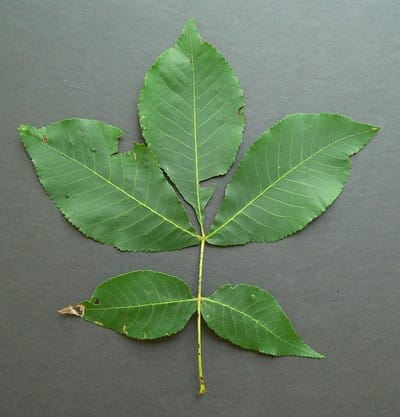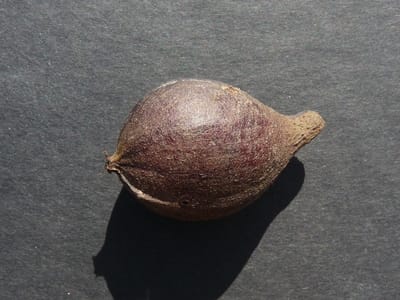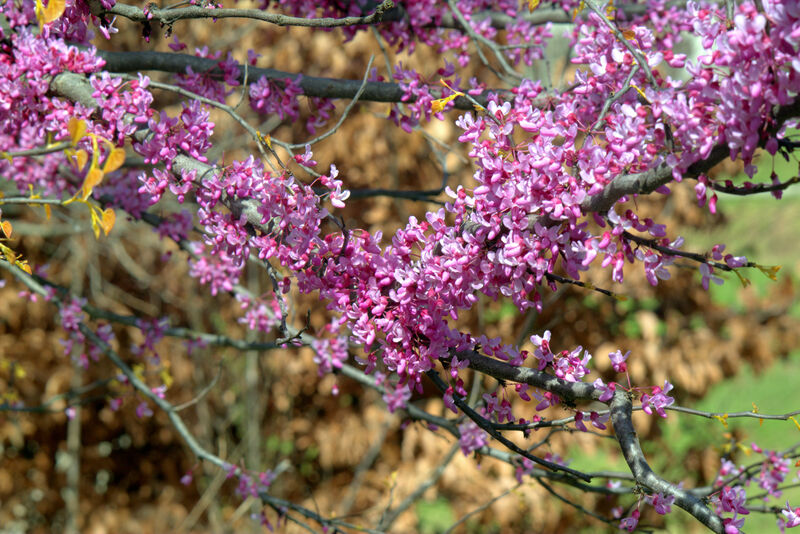Piedmont Oak-Pine-Hickory Forests
Oak-Pine-Hickory Forests are deciduous, closed-canopy forests that grow in very dry to nearly mesic places. Oaks are typically dominant, but hickories and other deciduous trees are often abundant, and pines are scattered throughout the forests. Steep, south-facing slopes in rugged terrain, on exposed knobs, and in rocky, thin soils are very dry. Flatter terrain with deeper soils will support submesic to nearly mesic stands.
Most oak forests grow in fairly acidic soils in the Georgia Piedmont, but some are underlain by mafic rocks or marble, with higher pH soils that support greater plant diversity. An abundance of hickories, elms, ashes, viburnums, and maples and far fewer blueberries and other ericaceous plants are good indicators of higher pH sites. This page describes how bedrock affects plant composition.
What's special: These are the "matrix" forests of the Piedmont, covering much of our green spaces, with other natural communities embedded within. These widespread forests provide habitat for many animals. Acorns and other nuts, berries, leaves, leaf litter, fruits, and nectar in many different vegetation layers provide a diversity of food and shelter. These forests support enormous numbers of caterpillars, which are the main source of food for birds feeding their young. Importantly, temperate deciduous forests, with their changing seasons, are special, globally uncommon forests.
Conservation: Ecologists generally believe that periodic fire is needed to sustain the presence of oaks in the forests. Without fire, shade tolerant, thinner-barked trees, such as red maple and black gum, grow under the oak tree canopy and shade out oak saplings. The oaks do not regenerate and are gradually lost from the forest.
Grades to: Mesic (moist) forests in shadier sites; pine-oak woodlands in drier or more fire-prone sites.
Most oak forests grow in fairly acidic soils in the Georgia Piedmont, but some are underlain by mafic rocks or marble, with higher pH soils that support greater plant diversity. An abundance of hickories, elms, ashes, viburnums, and maples and far fewer blueberries and other ericaceous plants are good indicators of higher pH sites. This page describes how bedrock affects plant composition.
What's special: These are the "matrix" forests of the Piedmont, covering much of our green spaces, with other natural communities embedded within. These widespread forests provide habitat for many animals. Acorns and other nuts, berries, leaves, leaf litter, fruits, and nectar in many different vegetation layers provide a diversity of food and shelter. These forests support enormous numbers of caterpillars, which are the main source of food for birds feeding their young. Importantly, temperate deciduous forests, with their changing seasons, are special, globally uncommon forests.
Conservation: Ecologists generally believe that periodic fire is needed to sustain the presence of oaks in the forests. Without fire, shade tolerant, thinner-barked trees, such as red maple and black gum, grow under the oak tree canopy and shade out oak saplings. The oaks do not regenerate and are gradually lost from the forest.
Grades to: Mesic (moist) forests in shadier sites; pine-oak woodlands in drier or more fire-prone sites.
|
Plants
Click on a plant name to see images. Plants are listed in order by scientific name. Terms such as "rich", "calcareous" and "mafic" are from The Flora of the Southern and Mid-Atlantic States, here. Trees Chalk maple Acer leucoderme (esp. mafic or calcareous rock) Red Maple Acer rubrum Pignut hickory Carya glabra Red hickory Carya ovalis Shagbark hickory Carya ovata (esp. mafic rock) Pale/Sand hickory Carya pallida Mockernut hickory Carya tomentosa Redbud Cercis canadensis (esp. calcareous or mafic rock) Flowering dogwood Cornus florida Eastern red cedar Juniperus virginiana (most abundant on circumneutral soils) Sweetgum Liquidambar styraciflua Blackgum Nyssa sylvatica Sourwood Oxydendrum arboreum Ironwood/American hop-hornbeam Ostrya virginiana (esp. over basic rocks) Shortleaf pine Pinus echinata Loblolly pine Pinus taeda Virginia pine Pinus virginiana White oak Quercus alba Scarlet oak Quercus coccinea Southern red oak Quercus falcata Blackjack oak Quercus marilandica Rock chestnut oak Quercus montana Northern red oak Quercus rubra Post oak Quercus stellata Black oak Quercus velutina Sassafras Sassafras albidum Red elm/Slippery elm Ulmus rubra (calcareous) Shrubs Small-flower pawpaw Asimina parviflora Beautyberry Callicarpa americana Sweetshrub Calycanthus floridus Strawberry bush/Hearts-a-bustin, Euonymus americanus Witch-alder Fothergilla major Carolina buckthorn Frangula caroliniana (esp. over calcareous and mafic rock) Mountain laurel Kalmia latifolia (acidic, north-facing, nearly mesic slopes) Gorge rhododendron Rhododendron minus (acid) Oconee azalea Rhododendron flammeum (acid) Oneflower hawthorn (and other hawthorns) Crataegus uniflora (and other Crataegus sp.) Gorge rhododendron Rhododendron minus (acid0 Pinxter flower Rhododendron periclymenoides Big-leaf snowbell Styrax grandifolius Horsesugar Symplocos tinctoria Sparkleberry Vaccinium arboreum (acid, typically) Hillside blueberry Vaccinium pallidum (acid) Deerberry Vaccinium stamineum Mapleleaf viburnum Viburnum acerifolium Arrowwood Viburnum dentatum Vines Cross vine Bignonia capreolata Trumpet vine Campsis radicans Coralbeads Cocculus carolinus (especially where calcareous) Carolina jessamine Gelsemium sempervirens Carolina spinypod Matelea carolinensis (nutrient rich soils/rock) Virginia creeper Parthenocissus quinquefolia Yellow passionflower Passiflora lutea Muscadine Vitis rotundifolia Greenbrier (whiteleaf/sawbrier) Smilax glauca Poison ivy Toxicodendron radicans Ground Layer Wildflowers Spreading dogbane Apocynum androsaemifolium Hemp dogbane Apocynum cannabinum Harebell Campanula divaricata Pipsissewa Chimaphila maculata (sub-shrub) Green-and-gold Chrysogonum virginianum Pink lady's-slipper orchid Cypripedium acaule Common Elephant's-foot Elephantopus tomentosus Trailing arbutus Epigaea repens (sub-shrub) Eastern flowering spurge Euphorbia corollata White wood aster Eurybia divaricata Galax Galax urceolata Rattlesnake-orchid Goodyera pubescens Little brown jug/Arrowhead heartleaf Hexastylis arifolia Veiny hawkweed Hieracium venosum Quaker ladies/Bluets Houstonia caerulea Summer/purple bluets Houstonia purpurea Naked tick trefoil Hylodesmum nudiflorum Yellow stargrass Hypoxis hirsuta Solomon's plume Maianthemum racemosum Violet wood-sorrel Oxalis violacea Carolina phlox Phlox carolina Solomon's seal Polygonatum biflorum Carolina petunia Ruellia caroliniensis Starry campion Silene stellata Fire-pink Silene virginica Indian pink Spigelia marilandica (usually on circumneutral soils) Cranefly orchid Tipularia discolor Catesby's trillium Trillium catesbaei Perfoliate bellwort Uvularia perfoliata Ferns Ebony spleenwort Asplenium platyneuron Rattlesnake fern Botrypus virginianus (especially on nutrient-rich slopes) Hay-scented fern Dennstaedtia punctilobula Broad beech fern Phegopteris hexagonoptera (leaning to mesic) Christmas fern Polystichum acrosticoides Grasses, Sedges, and Rushes Hill cane Arundinaria appalachiana Upland oats Chasmanthium sessiliflorum Silky oatgrass Danthonia sericea Poverty oatgrass Danthonia spicata Nimblewill Muhlenbergia schreberi |
Representative Trees (in order by scientific name) Representative Shrubs in order by scientific nameRepresentative Vines in order by scientific name
Representative Wildflowers, in order by scientific nameRepresentative Ferns, in order by scientific name
|














































































